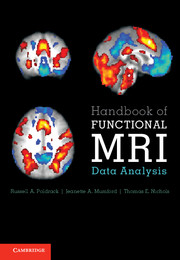Book contents
- Frontmatter
- Contents
- Preface
- 1 Introduction
- 2 Image processing basics
- 3 Preprocessing fMRI data
- 4 Spatial normalization
- 5 Statistical modeling: Single subject analysis
- 6 Statistical modeling: Group analysis
- 7 Statistical inference on images
- 8 Modeling brain connectivity
- 9 Multivoxel pattern analysis and machine learning
- 10 Visualizing, localizing, and reporting fMRI data
- Appendix A A Review of the General Linear Model
- Appendix B Data organization and management
- Appendix C Image formats
- Bibliography
- Index
7 - Statistical inference on images
Published online by Cambridge University Press: 01 June 2011
- Frontmatter
- Contents
- Preface
- 1 Introduction
- 2 Image processing basics
- 3 Preprocessing fMRI data
- 4 Spatial normalization
- 5 Statistical modeling: Single subject analysis
- 6 Statistical modeling: Group analysis
- 7 Statistical inference on images
- 8 Modeling brain connectivity
- 9 Multivoxel pattern analysis and machine learning
- 10 Visualizing, localizing, and reporting fMRI data
- Appendix A A Review of the General Linear Model
- Appendix B Data organization and management
- Appendix C Image formats
- Bibliography
- Index
Summary
The goal of statistical inference is to make decisions based on our data, while accounting for uncertainty due to noise in the data. From a broad perspective, statistical inference on fMRI data is no different from traditional data analysis on, say, a response time dataset. Inference for fMRI is challenging, however, because of the massive nature of the datasets and their spatial form. Thus, we need to define precisely what are the features of the images that we want to make inference on, and we have to account for the multiplicity in searching over the brain for an effect.
We begin with a brief review of traditional univariate statistical inference and then discuss the different features in images we can make inference on and finally cover the very important issue of multiple testing.
Basics of statistical inference
We will first briefly review the concepts of classical hypothesis testing, which is the main approach used for statistical inference in fMRI analysis. A null hypothesis H0 is an assertion about a parameter, some feature of the population from which we're sampling. H0 is the default case, typically that of “no effect,” and the alternative hypothesis H1 corresponds to the scientific hypothesis of interest. A test statistic T is a function of the data that summarizes the evidence against the null hypothesis. We write T for the yet-to-be-observed (random valued) test statistic, and t for a particular observed value of T.
- Type
- Chapter
- Information
- Handbook of Functional MRI Data Analysis , pp. 110 - 129Publisher: Cambridge University PressPrint publication year: 2011

